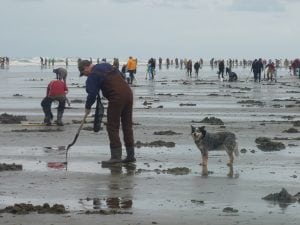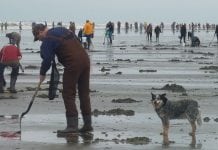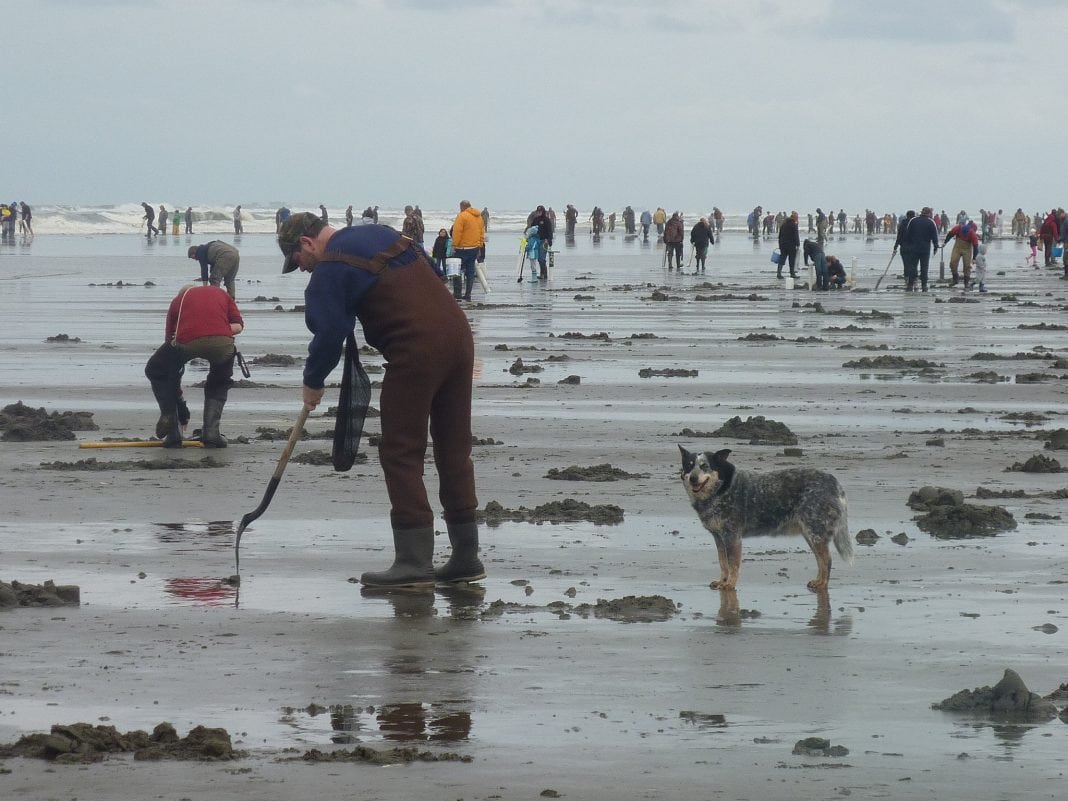Along the Washington Coast, the razor clam digging season is upon us. With the return of the rain and cold weather, hearty Pacific Northwest residents flock to the coast in hopes to get their limit of delicious mollusks. Considered to be one of the quintessential Pacific Northwest activities, clam digging is a fun, cheap and family-friendly activity that will provide delicious meals and incredible memories. Fun for all ages, all that is needed to clam dig is a permit, an implement to dig the clams and a container to put the clams in once you have found them. While that sounds easy enough, there are a handful of tips and information you’ll need to ensure a successful, safe and legal clam dig along the Washington beaches of the Pacific Ocean.
Where and When to Go Clamming

Stretching from Kalaloch Beach in Olympic National Park down to the southern end of the Washington Coast along the mouth of the Columbia River, numerous destinations are available to clammers. While many clam diggers have their favorite beach, the most important thing is to ensure that the beach you are planning to go to is open for clamming that day. Before heading out, it is also important to check the time of the upcoming tides. The lower the tide, the better clamming. Because of this, most clam digging dates are centered around low tides. In the fall and winter, the low tides take place in the dark, when it is often rainy and cold. Spring tides allow for daylight clam digging with a potential for better weather, but most serious clammers go during the fall and winter season.
A full list of open beaches and clamming dates can be found on the Department of Fish and Wildlife’s (WDFW) website. Please follow all rules and regulations about driving on the beaches. The beaches are broken up into five regions, as seen here:
- The Long Beach region starts at the mouth of the Columbia River and heads north, all the way to the mouth of the Willapa Bay.
- The Twin Harbors region extends from Willapa Bay north to the south jetty at the mouth of Grays Harbor, found in Westport.
- The Copalis Beach region stretches from the north jetty at the mouth of Grays Harbor in Ocean Shores all the way north to the Copalis River.
- The Mocrocks region sits between the Copalis River as the south boundary and runs north until it reaches the boundary of the Quinault Indian Reservation.
- The Kalaloch region runs from the South Beach campground, all the way north to Olympic National Park’s Beach Trail 3. Keep in mind that this beach is often closed to harvest.
What to Bring
Permit

Without a permit, you can’t clam dig. All diggers age 15-years or older are required to have a current license to harvest razor clams on any beach. You can choose a license based on how long you plan on going clamming this season. Your choices are between a three-day razor clam license or an annual combination clamming and fishing license. These licenses are available on WDFW’s website and from license vendors around the state. Each clam digger is allowed to take up to 15 razor clams per day. It is important to note that you are legally required to keep the first 15 razor clams you dig, no matter the size or condition, and that each digger must keep their clams in their own container.
Warm clothes
Once you have your permit, you’ll need to be properly outfitted for clam digging. The fall and winter clam digging season has the best tides at night, meaning that you stand a good chance to be cold and wet. We recommend at the minimum, having a sturdy pair of rubber boots, rain pants, a warm hat and a rain jacket, as well as a lantern or headlamp. Always layer in case the weather gets nicer, but assume it will be wet and cold. Do not head out unprepared.
Clamming Tools

Razor clam diggers have two options for getting a clam. You can choose between a shovel or a clam “gun.” The shovel is straightforward and requires a bit of patience and practice before you can dig a clam with ease. The clam gun is a metal or PVC tube that you twist into the ground and pull out the sand all around the clam. Most beginners tend to use a clam gun for the ease and simplicity. A guide to use both tools can be found on the WDFW website, complete with graphs and a video. Remember to also have a container for every clam digger in your group.
How to Find a Clam
The key to a successful clam dig is to start digging before the low tide hits. By starting early, you can follow the tide out, looking for signs of clam activity. The ideal time to find clams are when they are “necking,” their necks are sticking out of the sand. However, more often you will have to look for the following three signs of clams:
- A dimple, which is a depression in the sand.
- A doughnut, which has a small hole and raised sides.
- A keyhole, which usually occurs in drier sand and looks like an hourglass or hole.
Typically, the larger sized holes indicate the larger clams. Clams will also occasionally squirt sand and water out of the hole where they are located, so keep an eye out. Once you spot the signs of a clam, you will need to be quick, as razor clams can be quite quick in soft, watery sand. After successfully digging your clam, be careful grabbing it, they are so named for their razor-sharp shells. After carefully placing it in your container, continue until you have your limit of 15 clams per person, per day.
For more information, visit the WDFW website and check our community calendars for the next clam dig dates.
Sponsored














































